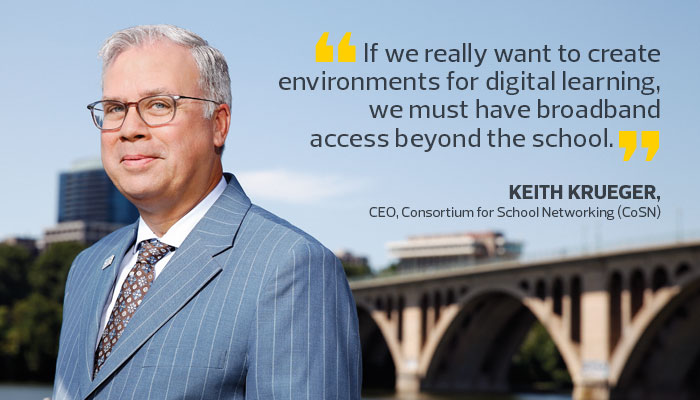Q&A: CoSN’s Keith Krueger on the Future of K–12 Networks
Process tends to derail the best-laid plans. Just ask Keith Krueger, CEO of the Consortium for School Networking.
Schools and districts are now well versed in how to apply for and obtain E-Rate funding to build better networks within their schools. The issue then? The focus needs to shift and begin addressing how to give access to students and staff when they’re not at school, Krueger says.
The future emphasis must be on broadband if districts truly want to reimagine education, he argues. EdTech magazine’s managing editor, Jena Passut, chatted with Krueger about how to change the way schools fund and plan for networks in order to best support teaching and learning going forward.
EDTECH: You conducted a work study on digital equity while you were an associate in practice at Harvard’s Graduate School of Education. Can you tell us what you learned?
KRUEGER: Digital equity is the civil rights issue of today. While we have been talking about the digital divide for the past two decades, the bulk of our time, energy and money has been about at-school access.
That made sense when most classrooms lacked broadband and Wi-Fi. But with the new, expanded E-Rate, we are on a path to solving that problem. If we really want to create environments for digital learning, we must have broadband access beyond the school.
The hardest aspect to solve is at-home access for students from low-income families. Households earning less than $25,000 a year are half as likely to have broadband internet access as families that are well-off. This is no longer simply “nice-to-have,” but core to learning today.
Unfortunately, more than 75 percent of school districts report that they are doing nothing about outside-of-school broadband access. My focus was on what innovative school leaders are doing about addressing digital equity.
EDTECH: How did you get into the field of educational technology?
KRUEGER: I backed into it from a background in policy work on Capitol Hill. My family are all educators, and I was working on telecommunications policy. I was less interested in industry fights than in how we use the internet to address urgent challenges in education, health and libraries. Eventually, I realized that I was good at building coalitions for public purposes (and I got a small shot at redemption from my family when I focused on using technology to transform learning).
EDTECH: What are some roadblocks educators face when it comes to implementing technology in classrooms?
KRUEGER: There are many, but I would say that ubiquity and access, as well as having leadership capacity, are at the top of the list.
By ubiquity I mean that every student and teacher needs his or her own device (or more than one), and it needs to have robust connectivity at school and outside of school.
The reality is that in too many places, we have managed our educational networks for scarcity rather than designing for digital learning. That requires leaders who see the potential for doing learning in new ways, not simply layering technology on top of what we have always done. Leaders must create the culture and vision for innovation.

EDTECH: What do we want learning to look like in, say, five or 10 years?
KRUEGER: Too often, we start with the cool new tools, rather than starting with learning.
For example, the maker movement is a big trend today, but school leaders should start by asking what problems they are trying to solve with those efforts. When that happens, we are driven by the educational need, not simply the new tools.
CoSN, in partnership with the New Media Consortium, annually produces the Horizon K–12 report on emerging technologies for learning. The new issue comes out in mid-September. This year, CoSN is releasing a toolkit with the free report to help educators have that conversation with their PTA, school board and other community members.
EDTECH: Every fall, CoSN conducts its infrastructure survey — in partnership with AASA, the School Superintendents Association — to understand broadband, Wi-Fi and the state of connectivity in the U.S. Is there reason to be optimistic?
KRUEGER: We will be releasing those findings in October. With the expansion of E-Rate and focus on broadband and Wi-Fi, we are making progress toward robust connectivity. But we cannot lose sight that there are serious challenges that remain, especially high recurring costs. Network speed, capacity, and lack of broadband competition in some communities, are very big challenges.
EDTECH: Finally, can you share your thoughts on how schools can bridge the homework tech gap?
KRUEGER: There are many things that can be done to address outside-of-school broadband access. Some school districts are putting Wi-Fi on buses so that time in transit can be productively put to learning. Others are loaning out mobile hotspots or paying for subsidized home internet access for low-income families.
Many school districts are partnering with local businesses to map out public Wi-Fi for students before and after school, and then working with their cities to fill in the Wi-Fi deserts in their communities so that the opportunities for learning are ubiquitous.
Increasingly, school systems will be making wide-area internet available from their schools to their learning resources in the surrounding communities. The bottom line is that there are many potential strategies and potential partners to address digital equity. But districts have to get started. They can download a toolkit on what we found and tips for action at cosn.org/digital-equity.









